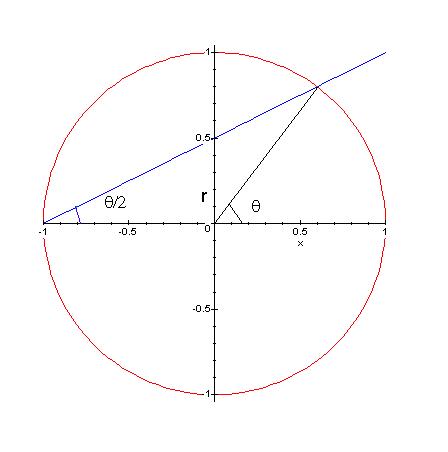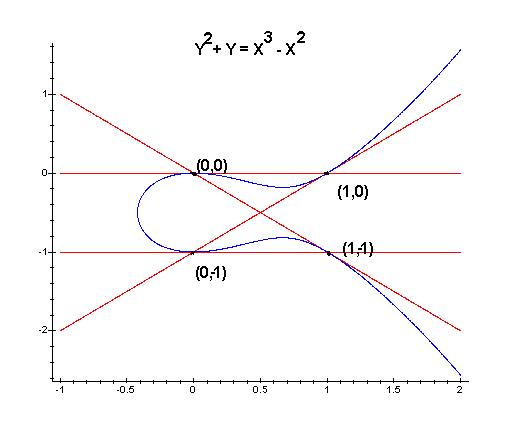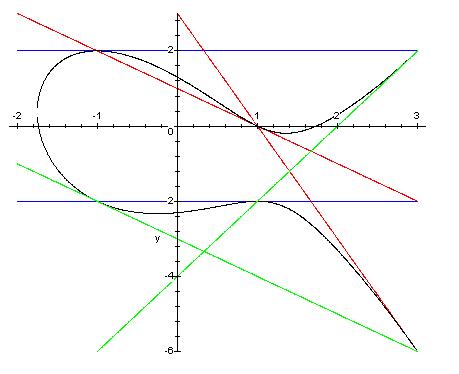
The main object of arithmetic geometry is to find all the solutions of Diophantine equations.
Examples:
Find all the rational numbers X and Y such that
|
Find all the rational numbers X and Y such that
|
Find all the rational numbers X and Y such that
|
The main idea is the following: consider the solutions (X,Y) in the real plane, and use geometric technics to determine the rational solutions.
Let's consider the first example:
|
The zero locus of this equation in the real plane is the radius 1 circle.
Now, consider a point in the circle with rational coordinates. For example:
|
Now, any straight line passing through (-1,0) cuts the circle on another point (except the vertical line).
What are the points that have rational coefficients? Exactly the ones such that the slope of the line is rational.
Algebraically:
A (non vertical line) is
|
The line contains (-1,0) if 0 = r ·(-1)+s, that is if s = r.
So the lines we are considering are the ones with equation
|

Now, the intersection with the circle of radius 1 is the simultaneous solution of this equation with
|
Replace Y by r ·X + r in this last equation. We get
|
|
Now, the solutions of this equation are
|
The solution X = -1 is the one we already know. The other solution is
|
So, we can see that if r is a rational number, X and Y are rational numbers (and viceversa).
We just found a (well known) parametrization of the circle.
So we have a formula for all the rational solutions of X2+Y2
= 1.
Non arithmetic application:
We know that the points of the circle can be parametrized by using trigonometric functions. They are the points:
|
Now, it is not hard to see that r is the tangent of q / 2.

So, we get the equations: If
|
|
Why this method works? Two reason's:
Fact: If we have a quadratic equation with rational coefficients
and we know one rational solution, then there are an infinite number of
solutions and they can be parametrized in terms of one parameter.
More examples:
The equation X2+Y2 = 2. We have an obvious rational point (1,1) (or (-1,1), (1,-1), (-1,-1)). Consider this last point: (-1,-1). Lines containing this point: Y = rX+(r-1). Intersection with the circle:
|
The equation
|
We have a rational point (-1,2).
Applying the same method we get that the solutions (other that (-1,2)) are:
|
Now, consider the equation in the beginning:
|
How we know? Transform it to a problem about integer solutions (X = A/C and Y = B/C):
|
First: 3 cannot divide A or B. Since if it does, it divides A, B and C, hence they are not coprime.
Second: Do modulo 3. We get
|
General answer (Legendre):
To know if a quadratic equation has no rational solutions, first see if it has real solutions.If it does, transform it to a quadratic equation (in three variables) and look for integral solutions.
Now, there is an integer m (computable in terms of the coefficients of the equation) such that the integral equation has solutions if and only if it has solutions modulo m.
Let's go to the next case: what happens with the cubic equations?
Claude
Gaspar Bachet de Méziriac (1581-1638). 
He is most famous for his Latin translation of Diophantus's Greek text Arithmetica (1621) in which Fermat wrote his famous Last Theorem marginal note.
In one of his books, he says the following:
Let c be a rational number. Suppose that (x,y) is a rational solution of the equation
|
|
How did he found this formula? No idea.
But we have a geometric interpretation of it.
The idea starts as before: Consider the zero locus of
|
Example: If c = -2, we have the solution (3,5). Now, the lines that go through (3,5) are Y = rX+(5-3r). If you substitute Y by rX+(5-3r) and expand, and then you divide by X-3 (it always divide), one gets that the X coordinates of the other points of intersection are the solutions of
|
|
|
So, what can we do? Consider the line that cut "two times" the curve in (x,y): the tangent line.
From the relation
|
In our case c = -2 and (x,y) = (3,5) we get the line with slope r = 27/10. Applying in the formula we obtain
|
You can see is the same number that in Bachet's formula.
In general, Bachet's formula gives use the coordinates of the intersection between the tangent line at (x,y) and the curve.
Applying this formula one gets:
|
|
|
|
and so on...
You can see that the numbers "increase" a lot (they don't increase in size, but in "height", that is the size of the integers giving the reduced form of the rational numbers appearing). This is a general fact, but this is another history...
In general, consider an equation of the form
|
If the equation is non-singular, one can use the following procedure:
Suppose we know a rational solution (x,y).
Formula: If (x,y) is a rational solution, then (x¢,y¢)
is another rational solution, where
|
So, it seems that we have found a procedure to compute infinitely many solutions if we know one. But this is not true!
For example, if y = 0, x¢ is not defined (or better, it is equal to infinite).
Another example: if x¢ = x, and y¢ = y, we get no new point.
Problem: what else could happen?
Beppo
Levi (1875-1961)
He conjectured in 1908 that there is only a finite number of possibilities, and gave the exact list.
This conjecture was made after him by T. Nagell (1952), A. Ogg (1971).
Finally, B. Mazur proved this conjecture in 1977 in a celebrated paper.
Barry Mazur 
Theorem (Mazur)
Let (x,y) be a rational point in an elliptic curve. Compute x¢, x¢¢, x¢¢¢ and x¢¢¢¢. If you can do it, and all of them are different, then the formula before gives you infinitely many different points.
In modern language:
If (x,y) is a rational torsion point in an elliptic curve of order N, then N £ 12 and N ¹ 11.
Examples:
|
|

(to get an equation like before, substitute Y by Y-1/2)
|
|
(to get an equation like before, substitute Y by Y-1/2(X+1))

Further developments:
L. Merel in 1996 proved, using the work of a lot of people like Kammieny, Manin, Faltings, Kolyvagin, Logachev, the following result.
Theorem:
For any integer d ³ 1, there is a constant Bd such that for any field K of degree d over Q and any elliptic curve over K with a torsion point of order N, one has that N £ Bd .
P. Parent found an specific constant, which is exponential in d.
Conjecture: There is a constant which is polynomial on d.
Theorem (Hindry-Silvermann): If E has good reduction everywhere, then N £ 1 977 408 d log(d)
What happens if we have curves of higher degree? (In more technical
terms, of higher genus).
A similar conjecture can be done:
Conjecture: For any g ³ 1, there exists a constant Cg such that, for any abelian variety of dimension g (e.g. the jacobian of a curve of genus g) defined over Q, and any rational torsion point of exact order N, then N £ Cg.
Nothing is known about this conjecture.
Theorem There is an specific constant C(g,p) such that any abelian variety of dimension g defined over Q such that it's reduction at p does not contain Gm, and any rational torsion point of exact order N, then N £ Cg.Finally, a guess:
Conjecture If g = 2, N = 31 cannot appear.